Southall garage's Ealing to Greenford route, which saw a wide
range of types during its 35 year life. Its history is
closely linked to that of route 97.
Looking rather the worse
for wear, RF453 working HW166 sets down a good load at Ealing in
1960.
26 Nov 58 to 30 Jun 64
(total 5 years 7 months, all crew operation).
Destinations
EALING BROADWAY STATION and GREENFORD Red
Lion
RF Garages
HW Southall
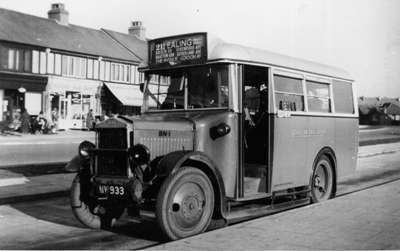
Reason for single-deck operation
Single-deck operation was required due to low trees, which the
local authority declined to cut until finally persuaded
in 1964. See also the notes by Keith Williams at the
foot of the page.
London Transport's smallest
bus. 14-seat Bean BN1 was one of three with specially built
narrow bodies for the start of the route in 1931, and survived into
the London Transport era.
Photographer unknown, photo
thanks to Friends of Classic London Buses of the Fifties
Route history
Introduced by Mrs VFA Sayers ('Royal Highlander') in May 1931,
the route originally ran from Greenford
Hare &
Hounds to West Ealing Station, but was rerouted to Ealing
Haven Green in September of that year. The
route was purchased by LGOC in September 1932 along with Highlander
route 225, which ran from Ealing to Greenford
Rutland
Road; the latter was suspended while the buses were made fit,
then in November 1932 replaced between Greenford and Ealing by an
increased service on the 211. Sunday services on the 211 were
withdrawn during 1933. The route number, having been
issued in the
independents' series, did
not need to change in the 1934 renumbering.
The routes were started with three one-man operated Beans,
specially built to a narrow 6’6" width due to projecting trees in
Gordon Road. These were classified BN by LGOC and allocated
to Hanwell Garage (HW, renamed Southall in 1950).
Two were replaced in May 1933 by new Dennis Darts DA41 and 42, also
built to a 6'6" width. Both Beans and Darts had longitudinal
seating (for 14 and 17 respectively), similar in layout to the
wartime conversions of the LTL Scooters, but one or two of the
Beans continued to work alongside the Darts until all were replaced
by new 20-seat Cubs in May 1936, still one-man
operated.
The route became crew-operated with five 30-seat 11T11
AEC Regals in May 1939. These were Ts 208, 213, 215 (still
green), 216 and 223, the first of 24 out of the total of 31 of
these Country Area buses to be painted red; more followed
when the route was extended in 1941. It was a sign of how
busy the route had become. In 1942, the buses were converted
to perimeter seating, to fit more standing passengers, for the
duration of the war.
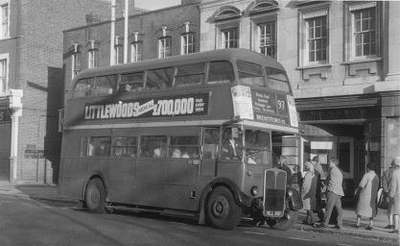
The history of the 97 and 211 are closely linked.
Southall's RT3571, having worked a southbound 97 from
Ruislip, boards at Ealing
Haven Green.
Photo © N
Rayfield, Ian Armstrong collection
The primary reason for this growth in
traffic was the extensive building programme that was
covering the fields of west London during the thirties. As
Keith Williams (see below) points out, one such area is the large
Cuckoo Estate, east of Greenford Road, built between 1933 and
1939 (see the
Cuckooites
web site). The only other bus along Greenford Avenue (the 55)
went to West Ealing and Acton via Northfields and thus by-passed
Ealing Broadway.
The Greenford terminus changed several times, first in
1933 to Eastmead Avenue, about a quarter of a mile short of the
Hare & Hounds, then in 1937 a quarter-mile beyond to
Adrienne Avenue, then the route was cut back to the Red Lion at the
start of 1941. In October of that year, the route was
extended over new bus roads via Yeading and West End Road
to Ruislip, terminating initially at the Lido, shortened after
two years to Ruislip High St. In 1946, Sunday
working was reintroduced, along with a summer Sunday
service to Ruislip Lido annually until 1951. At Ealing, the
Haven Green terminus involved a clockwise circuit of the Green to
stand on the east side, returning via Central Road direct to the
north-west corner.
During the winter of 1948/9, many of 11T11s succumbed
to the second batch of new 33-seat TDs, with Ts working on
Sundays only by April 1949. A further three were
replaced temporarily by 35-seat 14T12s from June that year.
From then on, the bulk of the service was provided by TDs, but with
a handful of Ts scheduled until the route was shortened in
1952.
Weymann-bodied post-war T760 sits on the
stand in Windmill Lane, Greenford in front of RT4466 on the 55,
also from Southall Garage (as Hanwell had been renamed in
1950). Behind is the market (now demolished), and the sign
for the café (see below) is just visible.
Photo Peter Osborn collection
John A Gray writes that the first two TDs to replace the
11T11s in the autumn of 1948 were TD51-52, followed after a
short gap by TD59-65, another gap, then TD103 and finally TD124 as
a spare. His neighbour, a driver, was disappointed in the TDs
- disappointingly sluggish uphill and 'just as much a handful as
the Ts'. The older Ts were replaced in 1951 by a batch of
repainted Country 10T10s, then they and the TDs were replaced by
post-war 14T12s in January 1953, part of the ripple effect caused
by the arrival of RFs at Sidcup.
The whole Greenford to Ruislip section, including the summer
Sunday extension, passed to Brentford to Greenford via Ealing route
97 from April 1952, so the 211 reverted to its pre-1937 length,
running to Greenford Adrienne Avenue in Monday to Friday
peaks for a further two months, but otherwise terminating at the
Red Lion. It would appear from the later change back (see
below) that this was necessitated by the need for greater capacity
on the northern section.
One of the contributors to the Cuckooites site (see above)
noted that 'the River Brent used to flood and we couldn't get
through to Greenford on the 211 bus, then later they redirected the
road [Ruislip Road East] and it was much better.'
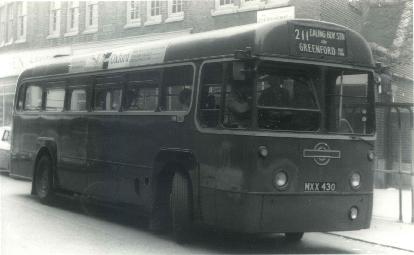
In November 1958, Sidcup routes
228 and
241 were
double-decked, releasing RFs to replace the Ts at Southall.
After so much change, the route settled down to a regular service
for five years.
RF453 again, at Ealing
again, this time working HW165.
Photo © Vectis Transport
Publications
Given LT's clear preference for double-decking routes wherever
possible, the 211's was a late conversion to RTs. LT's
Central Area Traffic Committee identified a problem in November
1963 which provided the impetus. The 97 crews took their
breaks at Brentford, but the local café closed in 1963 leaving them
with no refreshment facilities. The Committee noted that it
might be possible to persuade the local authority, Ealing Council,
to cut the trees along the 211 thereby allowing it to be
double-decked and extended to Ruislip, in turn allowing the 97 to
terminate at Greenford where there was a café.
Refreshment facilities at Greenford used to be provided by
canteen 689J, the former ST969, as
shown in the late John Hambley's 1949 book (p.108); latterly
the crews used the café in the market adjacent to the Windmill
Lane terminus (why that café couldn't be used earlier is not
known). Talking of canteens, the shorts on the 97 used to
terminate at Ealing
Perivale Lane, an area now much
changed but located a few hundred yards north up Argyle Road from
the famous terminus of the
65. At which point,
the HW tractor used to leave a two-tone green
canteen trailer (see the
YouTube video)
each day, just behind where the STL stands in this
2009 photo, © Peter
Osborn. This was HW's only canteen trailer, and HW did not
provide buses for the 65. Keith Williams recalls it from 1964
to 1966 and that it was only there Monday to Friday.
He remembers one morning a 65 NB crew refusing to take their
bus back south until the trailer turned up.
After work by the schedules department identified that the
change to the 211 and 97 was feasible, Ealing Council agreed
in February 1964 to make a test with a double-deck vehicle along
the route, to see what work was required. This was carried
out in April, ready for the conversion on 1 July.
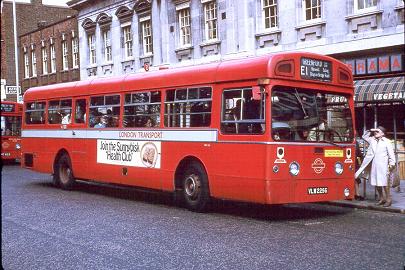
Other reasons for the 211 not being double-decked
earlier are suggested by Keith Williams in his notes below,
which may well have also formed part of the discussion, although
not mentioned in the minutes. In advance of the change, from
1 Dec 63, the westbound routing in Ealing was changed to
remove the sharp turn off Haven Green.
The RTs arrived on the 211 on 1 Jul 64, at the same time
swapping the Greenford to Ruislip Station section with the 97 on
Mondays to Saturdays as planned. Sunday workings
continued unchanged, the 97 retaining its Sunday working through to
Ruislip Lido in summer and Ruislip Station in winter.
MBS225 working from Hanwell
on the 211-replacement route E1, again seen at Ealing Haven
Green. An elderly passenger seems unsure about this
new-fangled form of transport, one hopes she wasn't required to
stand. This is a Sunday - behind is Alperton's MB621
working the short-lived Sunday-only 83A
to Wembley Empire Pool.
Photo © Cliff Essex
In November 1968, in phase two of the
Reshaping Plan, both 97 and 211 were replaced by
the flat-fare MBS-operated E1 and E2 between
Brentford, Ealing and Greenford, with new
Southall RT route 273 taking a third route from Ealing and
covering the section beyond Greenford.
RF route in detail, with timing points
EALING BROADWAY STATION, Haven Green, Gordon Road, The Avenue,
Sutherland Avenue, Sutherland Road, Drayton Green, Drayton Bridge
Road, Greenford Avenue Drayton
Bridge Road, Greenford Avenue, Ruislip Road East, The
Broadway, GREENFORD Windmill Lane (return via Otter
Road, Greenford Road to Ruislip Road East) (26 Nov 58 to 30
Nov 63)
EALING BROADWAY STATION, Haven Green, Castlebar Road, Longfield
Road (return direct to Haven Green), Gordon Road, The Avenue,
Sutherland Avenue, Sutherland Road, Drayton Green, Drayton Bridge
Road, Greenford Avenue Drayton
Bridge Road, Greenford Avenue, Ruislip Road East, The
Broadway, GREENFORD Windmill Lane (return via
Otter Road, Greenford Road to Ruislip Road East) (1 Dec 63
to 30 Jun 64)
The 1961 bus map shows both
the 211 as it was as an RF route, and the 97 from Brentford via
Ealing and Greenford to Ruislip; the Greenford to Ruislip section
highlighted was covered by the 211 both before and after RFs, but
not during. 1961 bus map © London Transport
Frequency
| Year |
M-F |
Sat |
Sun |
| 1936 |
15-23 mins |
15 mins |
- |
| 1938 |
13-15 mins |
13-15 mins |
- |
| 1941 |
12-15 mins |
12-15 mins |
- |
| 1946 |
10 mins |
10 mins |
- |
| 1951 |
5-6 mins |
5-8 mins |
9-12 mins |
| 1953 |
5-8 mins |
5-8 mins |
10-12 mins |
| 1959 |
5-8 mins |
5-8 mins |
9-13 mins |
| 1963 |
4-8 mins |
4-6 mins |
9-13 mins |
For years in which the route ran beyond Greenford, the
frequency between Ealing and Greenford is given.
The route took about 15 minutes from Ealing to
Greenford. The July 1967 timetable, by which time the route
was RT-operated, is
here.
Faretable
The 1966 faretable (when the route was RT-operated and had
been re-extended to Ruislip) is
here.
RF allocation
PVR 1958-64: Mon-Fri 8, Sat 8, Sun 6
Keith Williams remembers
using the 211 to go to school in Drayton Bridge Road,
Hanwell: 'RFs never had anything other than the Ealing
Broadway - Greenford "lazy blind" used - the drivers never
even bothered to change it for use on Southall Garage journeys
(always to - from Greenford via Greenford Road, although "via
Uxbridge Road" fares were included on fare charts). The
driver turned left into Greenford Road, stopped outside the main
Post Office in Greenford Road and told everyone to get off, whereas
in those days, ordinary journeys crossed over the Greenford Road,
passed the Red Lion and then turned left into Windmill Lane
stopping outside the market, sharing the stand with short working
55s. Short journeys on the 97 terminating at Greenford
Red Lion were unknown, although there were regular 97
short workings to Ealing Perivale Lane from
Brentford.
In RF days there were NO short workings on the 211, (although
of course there were both pre- and post- RF operation of the
route). As the “Southall Garage” display was very rarely used, and
HW never had any other RF route, I am sure that some RFs never had
their blinds turned even once during their stay at HW. The 'Ealing
Bdy and Greenford Red Lion' lazy blind created a feeling of
permanence and stability. The single deck OMO Flat-fare E1s,
after the 1964-68 RT interlude, came as a major and unwelcome shock
to the locals.
As a lad I remember that the 211 was HW's only single deck route
and it seemed to keep its own squad of regular crews for years,
through the TDs, 14T12s and then the RFs. These were probably
HW's oldest crews, shunted onto a single deck route that was far
from onerous [much in the way that the local single-deck route
was 'the old man's rota' at other garages - Ed]. But l
clearly remember one of the oldest of them all, a conductress, one
day telling all her passengers that she was retiring on the day
that the double deckers were coming, because she "wasn't running up
and down stairs at her age". We never saw her again. But we
never saw most of them again either. I think the majority of
the 211 crews went at the same time, for as soon as the RFs went,
it seemed that HW shared a lot of 211 staff rosters with those of
sister route 97 on a sort of alternating basis.'
He adds that the reasons for single deck working the 211 were
originally twofold.
(1) The poorly-fenced weak bridge by Drayton Green Halt, which
was on a snaking bend and had a very dodgy camber. It was the
rebuilding of this bridge that finally permitted RT operation.
(2) Ts and TDs were used because of their length. Buses
originally started from Ealing Broadway with a 120 degree right
turn to cross Haven Green. Then with Haven Green passed, there was
a sharp, narrow approximately 120 degree left turn to get on a
short southbound stretch before another narrow right turn into
Gordon Road. This section was rerouted 6 months before
RTs were introduced.
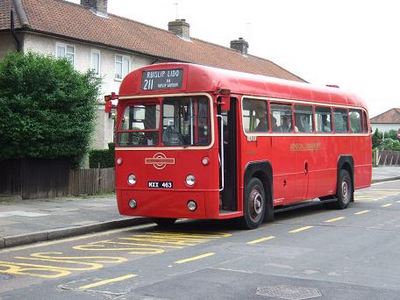
Re-creation
The Ruislip Lido section of the 211 (which never saw RFs in LT
service) was operated by RFs at the 2008 Uxbridge Running Day.
RF486 worked an extended
service south from Ruislip to reach the old terminus at Greenford
Red Lion - now clockwise, the reverse of the old
working.
Photo © Peter Osborn